Unit 1: Lessons 1 – 8
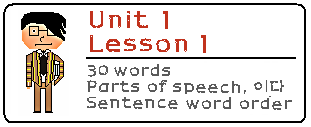 Lesson 1: In this lesson, you will learn the basic structure in Korean sentences and how to create sentences using the word 이다 (to be). Using 이다, you will learn how to create sentences like “that man is a teacher” and “this thing is a pen.” In addition, some essential grammar notes will be presented to get you started correctly in your path to learn Korean! Lesson 1: In this lesson, you will learn the basic structure in Korean sentences and how to create sentences using the word 이다 (to be). Using 이다, you will learn how to create sentences like “that man is a teacher” and “this thing is a pen.” In addition, some essential grammar notes will be presented to get you started correctly in your path to learn Korean!Also available in Español, Русский, Français, 中文, Deutsch, Português and Nederlands |
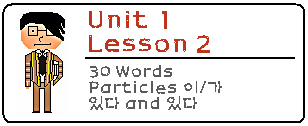 Lesson 2: In this lesson, you will learn two more particles (이/가) to use in Korean sentences. In addition to those, you will learn how to use the word 있다 to make sentences like “I am at school” and “I have a pen.” Lesson 2: In this lesson, you will learn two more particles (이/가) to use in Korean sentences. In addition to those, you will learn how to use the word 있다 to make sentences like “I am at school” and “I have a pen.”Also available in Español , Русский, 中文, Português, Français, Nederlands and Deutsch |
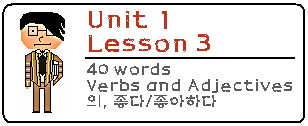 Lesson 3: In this lesson, you will learn how to make sentences using adjectives and verbs! We will start off with very simple sentences in this lesson, but later you will be making sentences complex enough to make your head explode. In addition to that, you will learn how to say “my” thing, or “his” thing by using the possessive particle, 의. Finally, we will take an initial look at the differences between 좋다 (to be good) and 좋아하다 (to like). Lesson 3: In this lesson, you will learn how to make sentences using adjectives and verbs! We will start off with very simple sentences in this lesson, but later you will be making sentences complex enough to make your head explode. In addition to that, you will learn how to say “my” thing, or “his” thing by using the possessive particle, 의. Finally, we will take an initial look at the differences between 좋다 (to be good) and 좋아하다 (to like).Also available in Español, Русский, Français, 中文, Português, Nederlands and Deutsch |
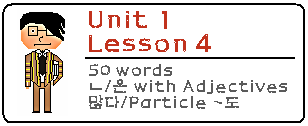 Lesson 4: In this lesson, you will learn how to change adjectives from their dictionary form to be able to modify nouns. Using this, you will be able to create more complex sentences! In addition to this, you will learn the meaning of the Korean particle ‘도’ and when to use it. Also, I included some common greeting words, even though I feel you should put off learning them for just a few more lessons! Lesson 4: In this lesson, you will learn how to change adjectives from their dictionary form to be able to modify nouns. Using this, you will be able to create more complex sentences! In addition to this, you will learn the meaning of the Korean particle ‘도’ and when to use it. Also, I included some common greeting words, even though I feel you should put off learning them for just a few more lessons!Also available in Español, Русский, Français, 中文, Português, Nederlands and Deutsch |
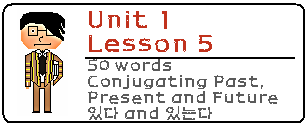 Lesson 5: This lesson will most likely be the hardest step you will have to take when learning Korean. There is a lot of content in this lesson, but don’t get too worried! The knowledge that you get from this lesson will literally be the first major building block you will need to start conjugating verbs and adjectives into the past, present and future forms. In addition, you will apply your knowledge of conjugating to 있다 and 있다 – two words that look the same, but have slightly different meanings. Lesson 5: This lesson will most likely be the hardest step you will have to take when learning Korean. There is a lot of content in this lesson, but don’t get too worried! The knowledge that you get from this lesson will literally be the first major building block you will need to start conjugating verbs and adjectives into the past, present and future forms. In addition, you will apply your knowledge of conjugating to 있다 and 있다 – two words that look the same, but have slightly different meanings.Also available in Español, Français, Русский, Português, Nederlands and Deutsch |
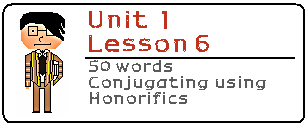 Lesson 6: In this lesson, you will add to what you learned in Lesson 5. In Lesson 5, you learned how to conjugate using one method. In this lesson, you will learn how to conjugate verbs and adjectives in polite and casual ways. You will also learn how to use the word “I” depending on the respect you need to show during speech. Lesson 6: In this lesson, you will add to what you learned in Lesson 5. In Lesson 5, you learned how to conjugate using one method. In this lesson, you will learn how to conjugate verbs and adjectives in polite and casual ways. You will also learn how to use the word “I” depending on the respect you need to show during speech.Also available in Español, Русский, Português, Nederlands, Deutsch and Français |
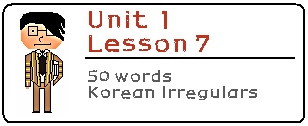 Lesson 7: In this lesson, you will learn all the Korean irregulars you will need to know when conjugating sentences. Like the previous lesson, this lesson is very heavy on grammar. Nonetheless, these irregulars must be understood/memorized if you want to conjugate verbs/adjectives properly. If you understand everything, but need to refresh your mind on exactly how to implement these irregulars, check out our Irregular Quick Reference page. Lesson 7: In this lesson, you will learn all the Korean irregulars you will need to know when conjugating sentences. Like the previous lesson, this lesson is very heavy on grammar. Nonetheless, these irregulars must be understood/memorized if you want to conjugate verbs/adjectives properly. If you understand everything, but need to refresh your mind on exactly how to implement these irregulars, check out our Irregular Quick Reference page.Also available in Español, Русский, Français and Português |
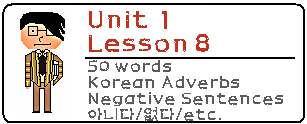 Lesson 8: In this lesson, you will learn a major part of speech that you haven’t learned about yet: Adverbs! You will be introduced to the various types of adverbs, and how you can use them in Korean sentences. In addition, you will learn about how to create negative sentences in a variety of ways. Lesson 8: In this lesson, you will learn a major part of speech that you haven’t learned about yet: Adverbs! You will be introduced to the various types of adverbs, and how you can use them in Korean sentences. In addition, you will learn about how to create negative sentences in a variety of ways.Also available in Español, Русский, Português, Nederlands, Deutsch and Français |
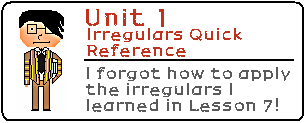 Irregulars Quick Reference: Use this lesson as a Quick Guide to remembering the various irregulars in Korean! If you can’t understand an irregular perfectly, check out Lesson 7 where each irregular is explained in detail. Or you could always ask us a question by making a comment! Irregulars Quick Reference: Use this lesson as a Quick Guide to remembering the various irregulars in Korean! If you can’t understand an irregular perfectly, check out Lesson 7 where each irregular is explained in detail. Or you could always ask us a question by making a comment! |
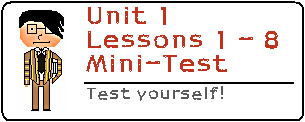 Lessons 1 – 8 Mini-Test: Test yourself on what you learned from these first eight lessons! A Mini-Test like this will be uploaded after every eight lessons. Don’t worry if the test doesn’t go so well – this website is here to help you! Lessons 1 – 8 Mini-Test: Test yourself on what you learned from these first eight lessons! A Mini-Test like this will be uploaded after every eight lessons. Don’t worry if the test doesn’t go so well – this website is here to help you!Also available in Русский, Français, Español, Português and Deutsch |
Comments
Post a Comment